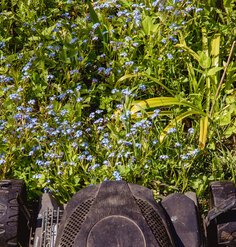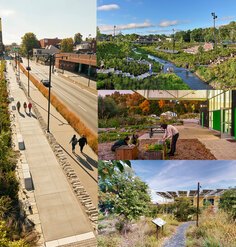From the Field: Maintenance - The Missing Link
By Scott Douglas, MLA Candidate, and M. Elen Deming, D.Des., Professor, Department of Landscape Architecture, University of Illinois at Urbana-Champaign
This summer, all three of the Chicago-land projects that we are studying as part of LAF’s Case Study Investigation (CSI) program share a common concern: the issue of maintenance. Maintenance levels and techniques can make or break a great project design, especially if the design innovates with new materials or plant aesthetics. If one goal of the designer-client team is to persuade the public to value such new combinations and effects, then it becomes imperative that maintenance is handled with the same level of commitment as the design, to help establish the new ecologies on-site and maintain the desired aesthetic. However, the effort of retooling and re-educating landscape maintenance staff is often far from an easy task.
During our initial meetings with the liaisons from three landscape architecture firms, the subject of maintenance frequently came up as a concern, sometimes even with a grimace. It is probably fair to say that many projects aren’t taken care of the way that designers envisioned when the projects were still on the drawing boards.
This maintenance issue has been exacerbated by the fact that the designs produced by today’s landscape architects have progressed dramatically from the work that was done 40-50 years ago. Landscape architecture has moved well beyond a focus on aesthetics, and we are now designing high-performance landscape systems that are an integral part of the site infrastructure. Bioswales, prairie restorations, functional wetlands, permeable paving, and other design features are commonly used to reduce the impact of new developments. However, as our site designs have become more precise and technical, has there been a reciprocal increase in skills, knowledge, and techniques on the maintenance end? Based on our recent interactions, we would conjecture that the long-term maintenance of many innovative projects is lagging behind.
One of the key variables is: Who performs maintenance service? Each of our three case study projects is maintained differently, ranging from dedicated professional staff to large volunteer group efforts.
Mary Bartelme Park is a city park that is managed and maintained by the staff of the Chicago Parks Department. We learned that the design team received some push-back from city staff on the idea of using prairie-like planting areas in the park, chiefly because of maintenance issues that had arisen in other parks with similar treatments. As a result, the species diversity of the prairie planting plant palette was reduced during the design phase, thus making it easier for Parks staff to recognize which plants should be growing in those designated areas. However, even with the reduced plant palette, instances still occur when native perennials and grasses are cut back at the wrong time of year, resulting in a loss of self-seeding opportunities and the varied seasonal visual interest that these plants can provide. This points to a need for continuing education for maintenance staff, greater involvement by designers, and better coordination between landscape contractors associations, such as the Illinois Landscape Contractors Association, and professional design associations like the American Society of Landscape Architects.
The Evelyn Pease Tyner Interpretive Center in Glen View, Illinois is maintained by a combination of city staff and volunteer groups. The volunteers remove weeds and collect seeds from the native plants in the prairie restoration area. Volunteer work days are organized several times per year and are typically attended by 10-25 people. At three hours per volunteer, this provides 30-75 person-hours of focused, detailed attention. Some individual volunteers go beyond that and dedicate well over 100 hours per year for invasive plant removal at the site. This added level of detailed attention is something that every designer wishes all of their projects received.
While touring the office buildings that surround the prairie, we were excited to see that the prairie aesthetic and its native plants had “overflowed” from the conservation area and seem to have influenced much of the landscape design on properties in the surrounding office park. Unfortunately, those plantings are not receiving the dedicated maintenance attention that the park is receiving, and they are quickly being overrun by more aggressive exotic invasive species. Worse, the establishment of invasive plant species so near the restored prairie threatens to reintroduce species so laboriously removed by hand.
Our third Chicago-land project is Loyola University’s Lake Shore Campus. The landscape is maintained by a dedicated maintenance staff that has successfully adjusted to a new native-heavy plant palette and an aesthetic style that recalls some of the native lakeside sand dune plantings. This team is thinking beyond general maintenance, as they are investigating opportunities to utilize the biomass that is collected from the campus plants, especially when the ornamental grasses are cut back. This is very forward-thinking from maintenance staff, possibly due to the overall ethos of sustainability that dominates the campus and all its missions. This also highlights the benefits of a dedicated staff working in close coordination with the designers and administrators to build capacity for new techniques and attitudes.
Since most projects do not benefit from dedicated maintenance staff or input from the maintenance team during the design phase, it is not surprising that parts of many projects fail during the first year or two after installation. Finger pointing doesn’t help. Landscape architects should be involved throughout the life of their projects, not just until the final walk through and the payment of their final design invoice. This does not suggest that landscape architects should create overly simplified designs in order to ensure that they are properly maintained. Instead, landscape architects should be more aggressive advocates for the long-term health and success of their constructed projects.
Clients and their staffs need to be educated about the significant importance of maintenance. This might include, for instance, bringing designers back to project sites for seasonal, or at least annual, visits. Landscapes are living, growing, and constantly changing projects that are never really “done,” so why should the landscape architect’s involvement end after installation? A weak design that is well maintained will quickly outshine an amazing design that is poorly maintained. Maintenance is, after all, the missing link between a good commission and a truly sustainable landscape.
Research Fellow M. Elen Deming and student Research Assistant Scott Douglas are participating in LAF’s 2015 Case Study Investigation (CSI) program and working to evaluate the environmental, economic and social performance of three exemplary landscape projects in the Chicago area. Any opinions expressed in this article belong solely to the author. Their inclusion in this article does not reflect endorsement by LAF.











